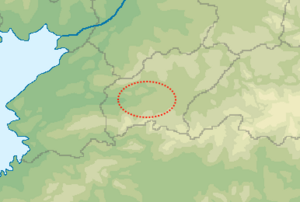Matu culture
 | |
| Alternative names | Rinkong |
|---|---|
| Geographical range | Miatsua valley |
| Period | Chalcolithic to Bronze age |
| Dates | 3300 BCE - 1200 BCE |
| Type site | Rinkong |
| Preceded by | Hua hunter-gatherers |
| Followed by | Valley state period |
The Matu Culture (Hua: ម តឿ mab tooj) was an archaeological culture located within the Miatsua valley region of modern day Tusing. It lasted from the late neolithic and early Chalcolithic into the early Bronze age, before being supplanted by other Hua groups in roughly 1200 BCE.
Historians believe that the Matu arose due to cultural contacts between the proto-Hua inhabitants of the Miatsua valley and the Southern Bashurat Valley Culture, which led the then predominantly hunter-gatherer Hua to adopt settlement-based agricultural techniques. According to the highly myth-based Tale of the Six Lords, the earliest written history of the Miatsua valley, the Matu were first led by a ruler named Wung Wong whose origins are described as divine. This myth of a divine king is repeated in the limited material traces of the Matu culture, such as in bronze decorated bowls. The Matu founded several villages, with the most important being the Rinkong archaeological site which is often considered to be the Matu type site. Matu presence is found across the Miatsua valley, and artefacts have been found which suggest trade with other cultures was present from the Chalcolithic era.
Objects found from this culture include pottery in the form of bowls and other household items, bronzework, and some jade carvings as well. Many of these hint at a religious usage, while bronze weapons and coinage have also been found. These artefacts hint at a highly developed social and religious order.
Overview
The name Matu comes from the Hua "ម តឿ" (mab tooj), meaning Bronze People. The Matu have alternatively been referred to as the Rinkong culture, coming from their type site. The Rinkong site spans over 130 hectares and is clustered around a river delta on the Pueng River. It is believed to have had a population of roughly 50,000 at its height and held relatively direct control over its neighbours. The town was walled, a common trend in Matu sites, and arranged along a grid plan that assigned each trade its own quarter.
The Matu are attested in the folklore of their successor states as being of divine origins and as progenitors of the Hua people. Their first ruler is named as Wung Wong, however as this name is derived from the Proto-Hua words for sky and king this is unlikely to be a true figure. The Matu's main crop was rice, though millet was also consumed as evidenced by bronze farming tools found at several sites. There were likely several wars in the Matu era between towns belonging to the same cultural group, but as the only source is the highly unreliable Tale of the Six Lords not much can be discerned from this.
The decline of the Matu culture is shrouded in mystery. The Tale of the Six Lords makes mention of a war between men and gods, which has been interpreted as a series of natural disasters, followed by the eclipse of Rinkong by other Hua states. Several archaeological sites show evidence of flooding, as well as damage which could be interpreted as being the result of an earthquake.
Society
While the lack of written sources from the era makes it hard to analyse the society of the Matu culture, there exist several artefacts which give an idea of certain aspects. From the ruins of Rinkong, there is a large central building which contained considerably more advanced patterns and craftwork. This, alongside the precedent of the valley states which succeeded, has led to Rinkong beong classified as a monarchy. The presence of quarters set aside for certain artesanal groups has led some historians to imply that Matu had a caste system similar to that seen in Saretic Bahia, though this is contested. The Matu population seems to have been highly urbanised for the era too, with trade being important to their economy.
Religion
The Matuan religion is not well understood, but likely resembled that of the Hua states which came after it. This is evidenced by the large quantity of statuettes, made of ceramics, bronze and jade which are believed to depict gods. Instruments relating to sacrifices have also been found, as well as pits filled with assorted bones near temple sites.
